The RCAF will acquire 14 P-8 aircraft, with options for other two, as part of the Canadian Multi-Mission Aircraft project.
Canadian officials announced the selection of the P-8 Poseidon for the Royal Canadian Air Force, after finalizing a government-to-government agreement with the United States for 14 aircraft and options for additional two aircraft. The P-8A will replace Canada’s current maritime patrol aircraft, the CP-140 Aurora, which has been in service for more than 40 years.
As it ages, the CP-140 aircraft is becoming increasingly difficult to support, expensive to sustain, and less operationally relevant in comparison to the threats against which it must defend. After significant engagement and thorough analysis, the government says that the P-8A delivers the best anti-submarine and intelligence, surveillance, and reconnaissance (ISR) capabilities for Canada.
“In today’s complex global environment, Canada requires a military that is capable of protecting our country well into the future. We are committed to ensuring that our current and future aviators have the most advanced equipment possible to do just that,” said Bill Blair, Minister of National Defence. “Canada requires a multi-mission fleet to contribute to the safety and security of Canadians and protect the sovereignty of a country with the longest coastline in the world. The Boeing P-8A Poseidon is the right aircraft to fulfil this role.”
Today, we announced that Canada selected the P-8A Poseidon as its new Multi-Mission Aircraft. Canada is acquiring up to 16 Poseidon aircraft, a proven capability operated by our Allies. @RCAF_ARC #WellEquippedhttps://t.co/10oSt6h3hM pic.twitter.com/vvl6p34v0J
— National Defence (@NationalDefence) November 30, 2023
Officials say this procurement will allow Canada to seamlessly transition to a replacement capability, thereby continuing to meet domestic needs and international obligations, while being able to operate seamlessly with allies. This platform, in fact, is a proven capability that is operated by all of Canada’s Five Eyes allies – the United States, the United Kingdom, Australia, and New Zealand – as well as other defence partners.
To defend Canadian interests in the country’s maritime approaches, the Arctic and internationally, the RCAF said it needs to be able to identify, detect, track and potentially engage advanced surface and sub-surface threats using an array of highly sophisticated sensors and weapons, while also having self-protection systems that provide survivability against known threats. The P-8A meets all requirements, according to the press release, enhancing Arctic security and national sovereignty and allowing to meet NATO, NORAD and other obligations well into the future.
“Canadians take great pride in their armed forces, and, in today’s global environment, it is more important than ever to ensure that those who serve our country have the right equipment to keep Canada safe and secure,” said Jean-Yves Duclos, Minister of Public Services and Procurement. “The purchase of the Boeing P-8A Poseidon will do just that, while also contributing to Canada’s aerospace and defence sector.”

The estimated investment for the project is $10.4 billion CAD, which includes up to $5.9 billion USD for the P-8A, associated equipment, training devices and sustainment set-up. The first P-8A is expected to be delivered in 2026, and with an average of one aircraft delivered per month, all of the aircraft could be delivered as early as fall 2027, with a full operational capability expected by 2033.
To that end, Boeing has plans to integrate Canadian companies in global supply chains, develop clean technologies and support the development of skills and training in Canada through meaningful business activities and targeted investments. The deal will generate more than 3000 jobs annually for Canadian industry and contribute at least $358 million annually to Canada’s gross domestic product over a ten-year period. This data adds up to the 81 Canadian suppliers already supporting the P-8 platform, which provide about CAD $4 billion in economic benefit to Canada and supporting more than 14,000 Canadian jobs.
“Our government will ensure that Canadian companies from coast to coast will directly benefit from this procurement,” said François-Philippe Champagne, Minister of Innovation, Science and Industry. “It will not only create good jobs, but also help grow our domestic aerospace industry. Boeing will be making strategic investments with leading Canadian firms and has also committed to growing its presence in Canada through further investments. We will continue to work with Boeing to ensure that Canadian companies can fully seize on all opportunities related to this important procurement.”
The CP-140 Aurora fleet, which will be replaced by the P-8 Poseidon, was originally procured in 1980 and is currently scheduled to retire from service in 2030. At that point, it will have been in service for almost 50 years and will face significant obsolescence challenges. The Aurora is employed both domestically, detecting security threats, illegal fishing, drug trafficking and polluters along the Canadian coastlines, and internationally, routinely participating in international missions, providing aerial Command, Control, Communications, Computers, Intelligence, Surveillance and Reconnaissance (C4ISR) support to coalition air operations.
Following a thorough market analysis, engagements with industry and Canada’s closest allies, and after assessing the findings of an independent third-party report, the Government says it has determined that the P-8A is the only currently available aircraft that meets all the Canadian Multi-Mission Aircraft (CMMA) project operational requirements. The decision was not short of controversy, as Canada also faced protests from Bombardier, which proposed a missionized Global 6500 jet variant. The government made it clear, however, that it needed an aircraft already available and currently in production, while Bombardier’s proposal was still a concept.
In the meanwhile, the CP-140 has been upgraded to the Block IV configuration to integrate and install new mission systems and sensors onto the CP-140 for ISR, while also replacing obsolete systems. This was the last step of the Aurora Incremental Modernization Project (AIMP), which also included beyond line-of-sight (BLOS) wideband satellite communications, Link 16 tactical data exchange network access, and infrared counter measures for self defence.
In addition to the AIMP, the RCAF completed the Aurora Structural Life Extension Project (ASLEP) which involved the replacement of wings and horizontal stabilizers on the CP-140, extending its operational life to 2030.









